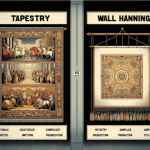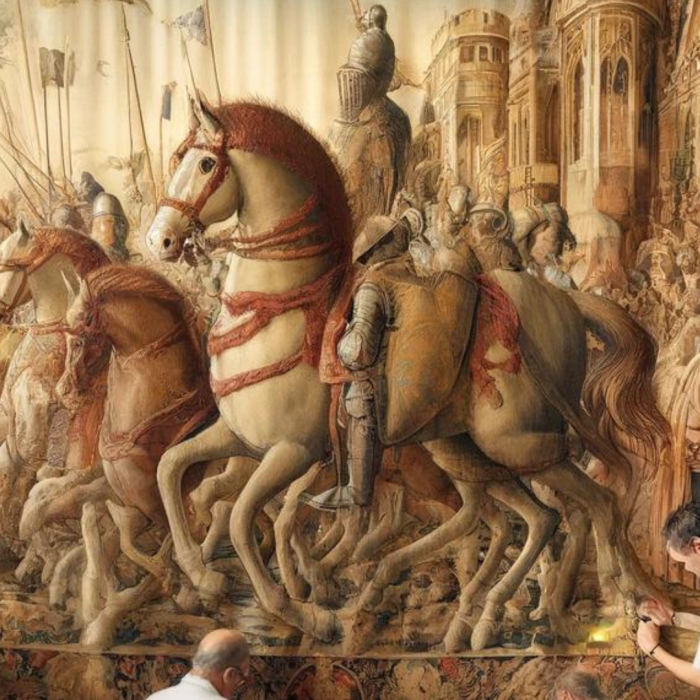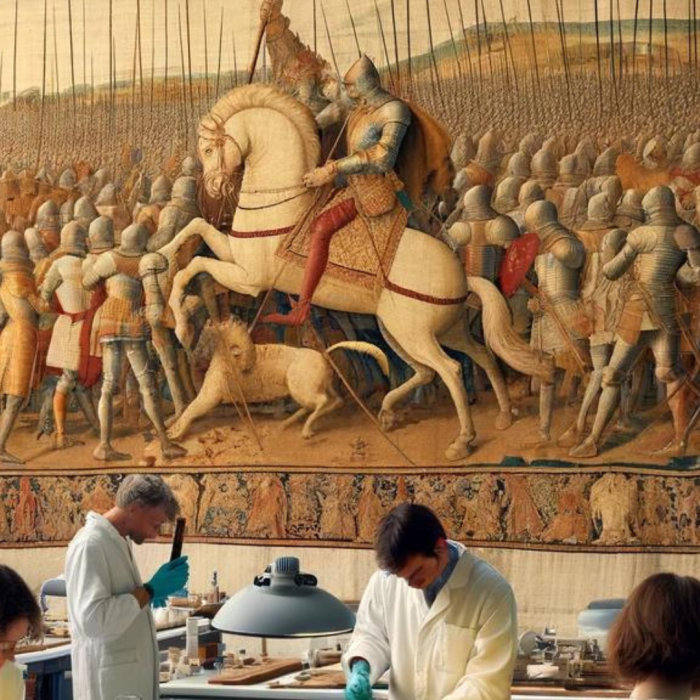The symbolism in tapestry designs
Tapestries are intricate and often large pieces of woven textile art that have been an integral part of human culture for centuries. These textile masterpieces are created by weaving different colored threads together on a loom to form a design. Unlike paintings, tapestries are made using threads of wool, silk, cotton, or other materials, giving them a unique texture and durability.
Historical Significance of Tapestries in Home Decor
Tapestries have a rich history that dates back to ancient times. They were not only decorative but also served practical purposes such as providing insulation and soundproofing in drafty castles and palaces. Throughout history, tapestries adorned the walls of grand estates, castles, and churches, showcasing the wealth and status of their owners. In more recent times, tapestries have become more accessible and are used to add elegance and character to modern homes. The historical significance of tapestries in home decor reflects the timeless appeal of these art pieces.
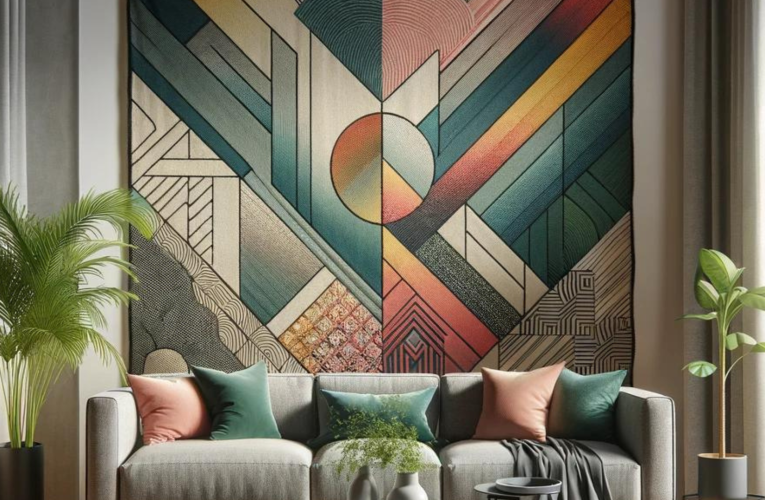
Transition to the Focus
Symbolism in Tapestry Designs Beyond their decorative function, tapestries are rich with symbolism that often reflects historical, cultural, religious, and mythological themes. In this blog post, we delve into the world of symbolism in tapestry designs. We will explore how tapestries have been used throughout history to convey narratives, decode historical and cultural events, and express religious and mythological stories. By understanding the symbolism in tapestries, we can gain insight into the deeper meanings behind these stunning works of art. Let’s embark on a journey to unravel the hidden messages woven into the fabric of tapestry art.
The Art of Tapestries
The Art of Tapestries” section delves into the production and significance of tapestries, focusing on their techniques, materials, historical background, and the importance of symbolism in this art form.
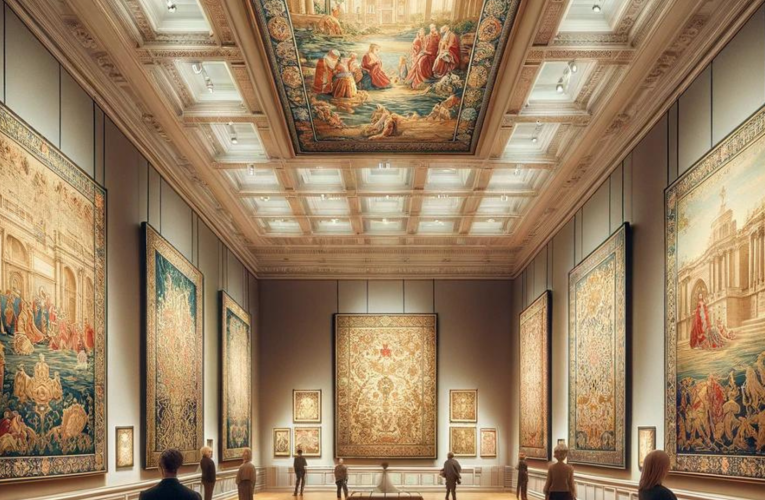
A. Overview of Tapestry Production
Tapestries are intricate textile artworks created by weaving together different colored threads to form designs and images. This process involves several techniques and materials:
Techniques and Materials
- Weavers use techniques like “weft-faced weaving,” where the weft threads completely cover the warp threads, creating a dense, richly textured surface.
- Various materials are used, such as wool, silk, and sometimes even gold or silver threads for embellishments.
- The weaving process is meticulous and time-consuming, often requiring skilled artisans to create even the smallest details in the design.
Historical Background of Tapestry Making
- Tapestry making has a rich history dating back centuries, with origins in civilizations such as ancient Egypt and Greece.
- Medieval Europe saw the rise of tapestries as prized possessions, used for insulation, decoration, and as storytelling tools.
- Notable tapestry-making centers include the famous Gobelins Manufactory in France and the Flemish workshops renowned for their intricate designs.
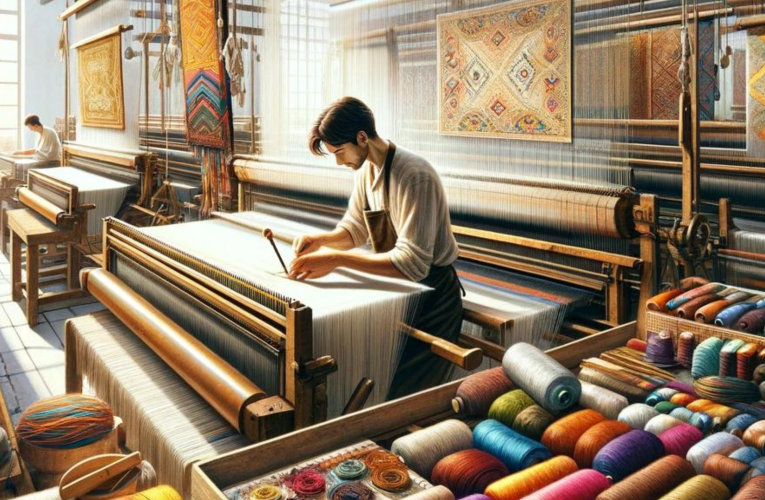
B. Importance of Symbolism in Tapestries
Symbolism plays a crucial role in the creation and interpretation of tapestries, bringing depth and meaning to the art form:
Introduction to the Concept of Symbolism
- Symbolism in tapestries involves the use of images, motifs, and colors to convey deeper meanings.
- These symbols often carry cultural, religious, or mythological significance, adding layers of interpretation to the artwork.
Role of Symbolism in Art and Culture
- Symbolism in tapestries serves as a visual language, allowing artists to communicate complex ideas and stories.
- It reflects the beliefs, values, and historical contexts of the societies in which the tapestries were created.
- In home decor tapestries, these symbols can transform a space, infusing it with narratives and themes that resonate with the homeowner.
Understanding the techniques used in tapestry production and the significance of symbolism provides a foundation for exploring how historical and cultural narratives, as well as religious and mythological themes, are depicted and decoded in these intricate artworks.
Historical and Cultural Narratives in Tapestries
A. Exploration of Historical Narratives
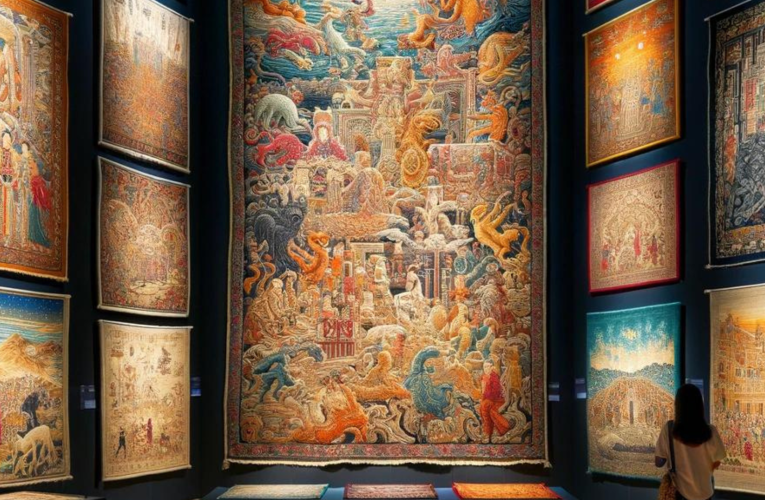
Tapestries are not just decorative pieces; they are historical documents woven into fabric. Through the ages, tapestries have depicted scenes from various historical periods, offering glimpses into the lives of people in different eras. For instance:
- Medieval Tapestries:
- These often depicted scenes from battles, royal courts, and daily life, providing a visual record of the medieval world.
- Renaissance Tapestries:
- During this period, tapestries became grander and more detailed, showcasing the opulence of the time. They depicted stories from classical mythology, historical events, and religious narratives.
B. Cultural Influences on Tapestry Designs
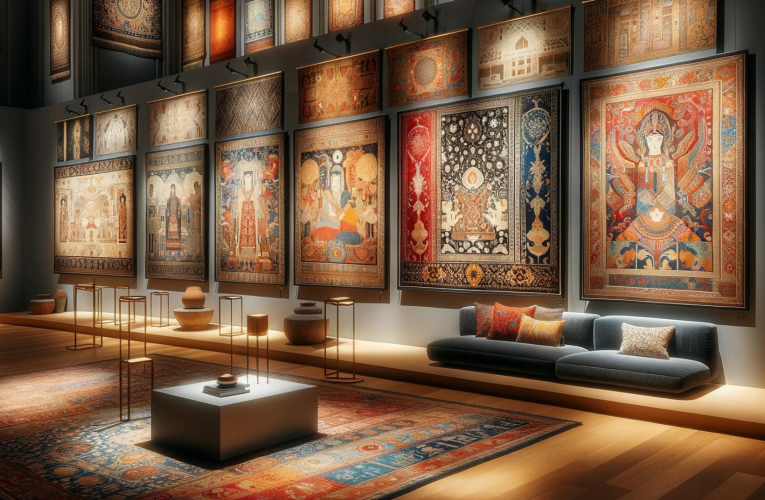
Tapestry designs were deeply influenced by the cultures in which they were created. Different regions developed unique styles and symbols, reflecting their cultural heritage:
- Regional Variations in Symbolism:
- For example, Flemish tapestries might feature intricate floral motifs and rich colors, while French tapestries could focus on scenes of courtly life.
- Historical Events Shaping Themes:
- Tapestries often commemorated significant historical events such as battles, coronations, or religious ceremonies. These events not only influenced the subject matter but also the symbols and motifs used.
C. Decoding Historical and Cultural Symbolism
Understanding the symbols woven into tapestries requires a knowledge of art history, mythology, and cultural contexts. Here are some methods for deciphering these symbols:
Iconography:
This involves the study of symbols and their meanings in a particular context. For instance, a lion might symbolize strength and courage.
Contextual Analysis:
Examining the historical context of the tapestry can provide clues to its meaning. For example, a tapestry created during a time of political unrest might have hidden messages.
Case Studies of Famous Tapestries:
Delving into specific examples can illuminate how symbols were used. For instance:
- The “Lady and the Unicorn” tapestries from the late Middle Ages feature enigmatic symbols such as the unicorn, which has been interpreted as a symbol of purity.
- The Bayeux Tapestry, depicting the Norman Conquest of England, is rich in symbols that convey the story of this pivotal event.
- By decoding the historical and cultural symbolism in tapestries, we gain not only a deeper appreciation for their beauty but also insight into the beliefs, values, and events of the past.
Religious and Mythological Themes in Tapestries
In the realm of tapestry designs, religious and mythological themes play a significant role in conveying deeper meanings and cultural narratives. Here’s a breakdown of how these themes are explored and decoded:
A. Overview of Religious Symbolism
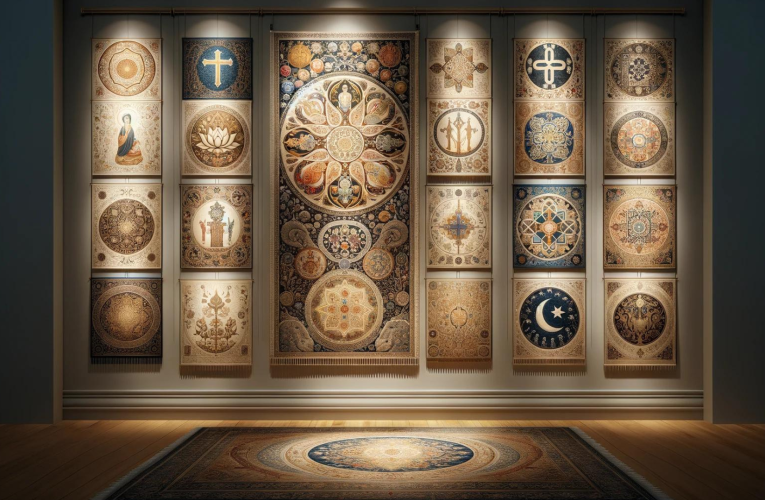
Religious symbolism in tapestries encompasses various faiths, including Christianity, Islam, Judaism, and more. These symbols are often used to depict religious stories, convey spiritual beliefs, and evoke a sense of reverence. For example:
- Christian tapestries might feature scenes from the Bible, such as the Nativity or the Crucifixi on.
- Islamic tapestries could include intricate geometric patterns representing the divine order or calligraphy of Quranic verses.
- Jewish tapestries might depict scenes from Jewish history or symbols like the Star of David.
B. Exploration of Mythological Themes
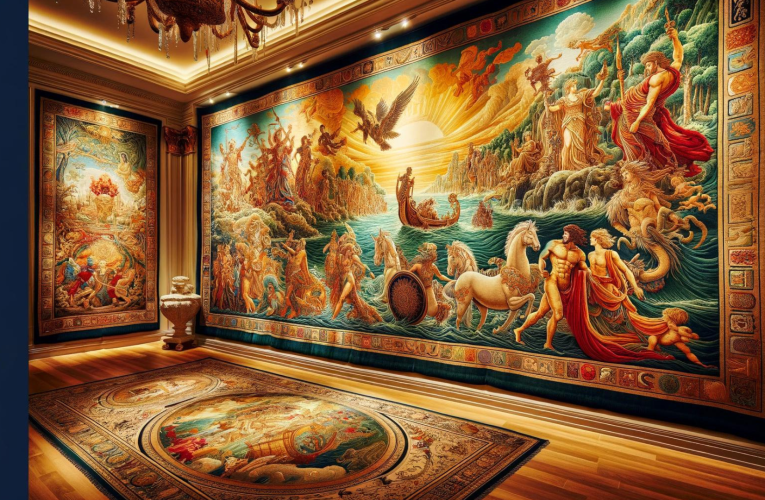
Mythological themes in tapestries draw from ancient stories and legends, often from civilizations like Greek, Roman, and Norse mythology. These tales are rich in symbolism and serve to reflect universal human experiences and archetypes. For instance:
- Greek mythology-inspired tapestries might depict the adventures of gods and heroes like Zeus, Hercules, or the Trojan War.
- Roman mythology themes could include stories of love, war, and the founding of Rome, with symbols like the she-wolf and the eagle.
- Norse mythology tapestries might feature Odin, Thor, and Loki, along with symbols like Yggdrasil, the World Tree.
C. Symbolism in Tapestries Decoding
Deciphering the symbolism in religious and mythological tapestries requires an understanding of the symbols’ cultural and historical contexts:
Understanding Religious and Mythological Symbols:
- Symbols like crosses, crescents, and stars carry deep religious significance.
- Mythological creatures such as dragons, unicorns, and phoenixes represent various qualities and themes.
Examples of Famous Tapestries with Religious/Mythological Themes:
- The Hunt of the Unicorn: This medieval tapestry series contains both religious and mythical elements, with Christian symbolism alongside the mystical unicorn.
- The Lady and the Unicorn: This famous set of tapestries features allegorical representations of the senses, intertwined with medieval Christian and romantic symbolism.
- The Labours of Hercules: A classical theme often depicted in tapestries, showcasing the hero’s trials and triumphs.
In decoding these tapestries, we uncover not only the stories they tell but also the values, beliefs, and cultural contexts of the societies that created them. The intricate weaving of religious and mythological symbols in tapestries adds layers of meaning, making them not just decorative pieces but windows into ancient beliefs and narratives. Whether displayed as home decor tapestries or admired for their historical and cultural significance, these works continue to fascinate and inspire, bridging the past with the present.
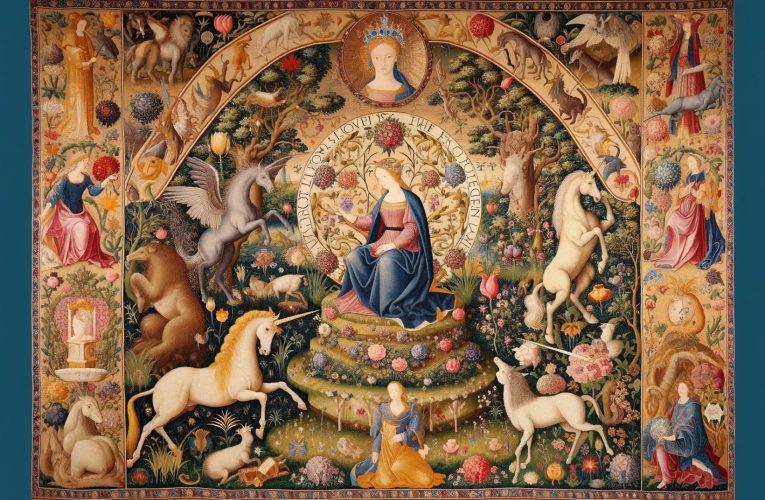
Contemporary Interpretations and Modern Use of Symbolism in Tapestries
Let’s delve into each part of the outline for the blog topic “The Symbolism in Tapestry Designs” with a focus on contemporary interpretations and modern use of symbolism in tapestries.
A. Evolution of Tapestry Designs in Modern Times
Tapestry designs have undergone significant evolution in modern times. Artists and designers today draw inspiration from various sources, blending traditional techniques with contemporary styles. This evolution includes:
Innovative Techniques:
Modern technology has enabled new methods in tapestry-making, from digital design to laser-cutting.
Abstract Interpretations:
Contemporary artists often experiment with abstract and avant-garde designs, departing from traditional narratives.
Diverse Themes:
Themes in modern tapestries range from socio-political commentary to environmental awareness, reflecting current issues and concerns.
B. Incorporation of Traditional Symbolism in Contemporary Tapestries
Despite modernization, traditional symbolism continues to hold significance in contemporary tapestries. Artists often incorporate:
Historical References:
References to historical events and cultural narratives persist, connecting modern works to their roots.
Cultural Heritage:
Traditional symbols from various cultures are reinterpreted, celebrating diversity and cultural richness.
Mythological and Religious Themes:
Mythological and religious symbols retain their allure, offering timeless depth to modern designs.
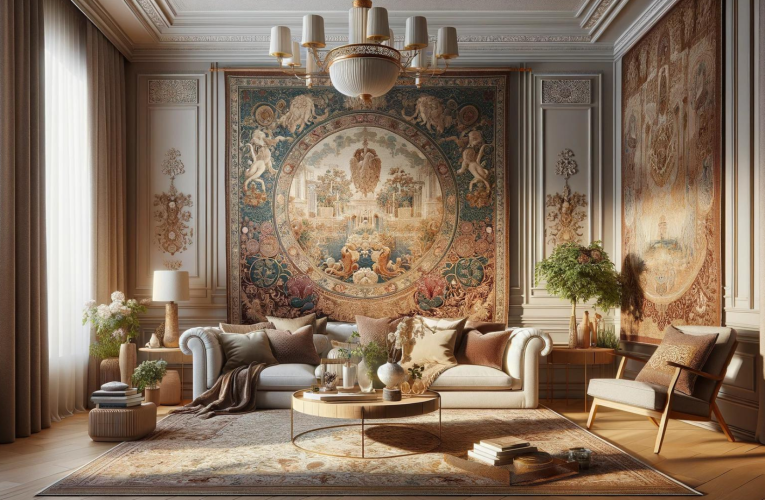
C. Role of Tapestries in Modern Home Decor
Tapestries have made a remarkable comeback in modern home decor, and their symbolism plays a vital role:
- Symbolism Adds Depth: Tapestries with symbolic motifs bring layers of meaning to home interiors, creating conversations and contemplation.
- Personal Expression: Homeowners select tapestries that resonate with their beliefs and interests, making them not just decor but personal statements.
- Versatile Decor: From large statement pieces to small accents, tapestries fit various home styles, from minimalist to eclectic.
- Functional Art: Tapestries serve as both art and functional decor, adding warmth and texture to living spaces.
D. Artists and Designers Using Symbolism in Tapestries Today
Several contemporary artists and designers are known for their exceptional use of symbolism in tapestries:
- Faig Ahmed: Known for his distorted and surrealistic rugs, Ahmed blends traditional Azerbaijani carpet weaving with modern art.
- Kiki Smith: This American artist often incorporates mythological and natural motifs in her tapestries, exploring themes of femininity and spirituality.
- Grayson Perry: A British artist whose tapestries reflect on contemporary life with a touch of humor and social commentary.
- El Anatsui: Though primarily known for his metal sculptures, Anatsui’s tapestries made from recycled materials carry strong cultural and environmental symbolism.
The symbolism in tapestry designs holds enduring significance in both traditional and contemporary contexts. From historical narratives to mythological themes, tapestries continue to be a medium of expression for artists and a source of inspiration for home decor. As we decode the rich symbolism in these artworks, we not only appreciate their beauty but also connect with the stories and meanings they carry. Whether ancient or modern, tapestries serve as timeless pieces that enrich our living spaces with history, culture, and personal significance.

